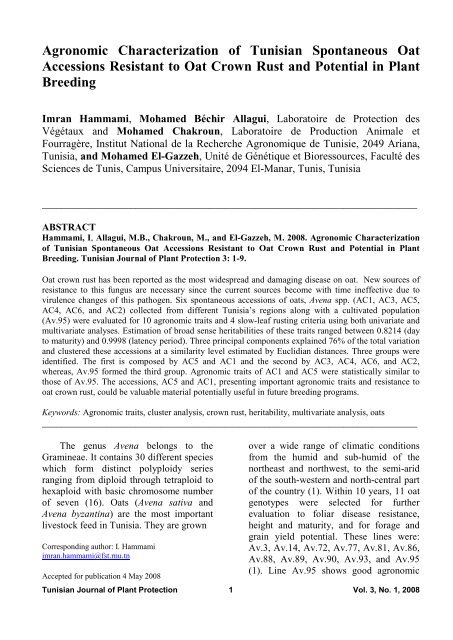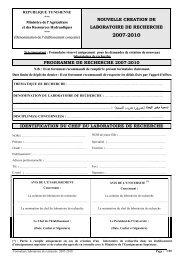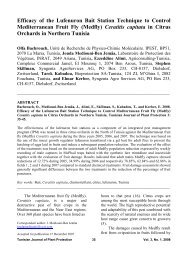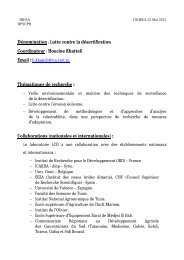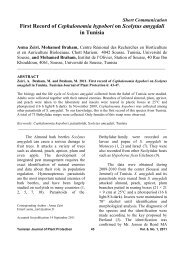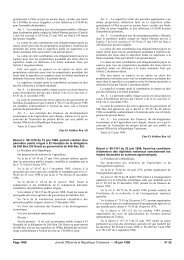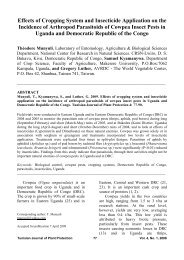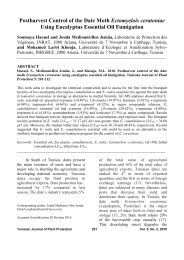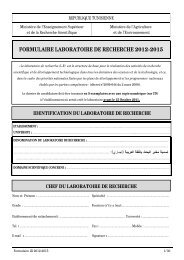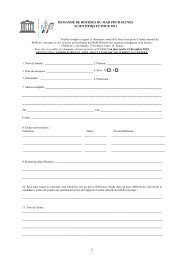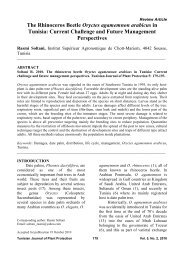Agronomic Characterization of Tunisian Spontaneous Oat ... - Iresa
Agronomic Characterization of Tunisian Spontaneous Oat ... - Iresa
Agronomic Characterization of Tunisian Spontaneous Oat ... - Iresa
Create successful ePaper yourself
Turn your PDF publications into a flip-book with our unique Google optimized e-Paper software.
<strong>Agronomic</strong> <strong>Characterization</strong> <strong>of</strong> <strong>Tunisian</strong> <strong>Spontaneous</strong> <strong>Oat</strong>Accessions Resistant to <strong>Oat</strong> Crown Rust and Potential in PlantBreedingImran Hammami, Mohamed Béchir Allagui, Laboratoire de Protection desVégétaux and Mohamed Chakroun, Laboratoire de Production Animale etFourragère, Institut National de la Recherche Agronomique de Tunisie, 2049 Ariana,Tunisia, and Mohamed El-Gazzeh, Unité de Génétique et Bioressources, Faculté desSciences de Tunis, Campus Universitaire, 2094 El-Manar, Tunis, Tunisia____________________________________________________________________________ABSTRACTHammami, I, Allagui, M.B., Chakroun, M., and El-Gazzeh, M. 2008. <strong>Agronomic</strong> <strong>Characterization</strong><strong>of</strong> <strong>Tunisian</strong> <strong>Spontaneous</strong> <strong>Oat</strong> Accessions Resistant to <strong>Oat</strong> Crown Rust and Potential in PlantBreeding. <strong>Tunisian</strong> Journal <strong>of</strong> Plant Protection 3: 1-9.<strong>Oat</strong> crown rust has been reported as the most widespread and damaging disease on oat. New sources <strong>of</strong>resistance to this fungus are necessary since the current sources become with time ineffective due tovirulence changes <strong>of</strong> this pathogen. Six spontaneous accessions <strong>of</strong> oats, Avena spp. (AC1, AC3, AC5,AC4, AC6, and AC2) collected from different Tunisia’s regions along with a cultivated population(Av.95) were evaluated for 10 agronomic traits and 4 slow-leaf rusting criteria using both univariate andmultivariate analyses. Estimation <strong>of</strong> broad sense heritabilities <strong>of</strong> these traits ranged between 0.8214 (dayto maturity) and 0.9998 (latency period). Three principal components explained 76% <strong>of</strong> the total variationand clustered these accessions at a similarity level estimated by Euclidian distances. Three groups wereidentified. The first is composed by AC5 and AC1 and the second by AC3, AC4, AC6, and AC2,whereas, Av.95 formed the third group. <strong>Agronomic</strong> traits <strong>of</strong> AC1 and AC5 were statistically similar tothose <strong>of</strong> Av.95. The accessions, AC5 and AC1, presenting important agronomic traits and resistance tooat crown rust, could be valuable material potentially useful in future breeding programs.Keywords: <strong>Agronomic</strong> traits, cluster analysis, crown rust, heritability, multivariate analysis, oats____________________________________________________________________________The genus Avena belongs to theGramineae. It contains 30 different specieswhich form distinct polyploidy seriesranging from diploid through tetraploid tohexaploid with basic chromosome number<strong>of</strong> seven (16). <strong>Oat</strong>s (Avena sativa andAvena byzantina) are the most importantlivestock feed in Tunisia. They are grownCorresponding author: I. Hammamiimran.hammami@fst.rnu.tnAccepted for publication 4 May 2008over a wide range <strong>of</strong> climatic conditionsfrom the humid and sub-humid <strong>of</strong> thenortheast and northwest, to the semi-arid<strong>of</strong> the south-western and north-central part<strong>of</strong> the country (1). Within 10 years, 11 oatgenotypes were selected for furtherevaluation to foliar disease resistance,height and maturity, and for forage andgrain yield potential. These lines were:Av.3, Av.14, Av.72, Av.77, Av.81, Av.86,Av.88, Av.89, Av.90, Av.93, and Av.95(1). Line Av.95 shows good agronomic<strong>Tunisian</strong> Journal <strong>of</strong> Plant Protection 1Vol. 3, No. 1, 2008
characteristic but screen-house and fieldobservation indicated that it is susceptibleto oat crown rust (Puccinia coronata f. sp.avenae). This disease is a real threat tooats; it can reduce grain yields and grainquality such as seed weight and groatpercentage (11). Research on resistancesources to oat crown rust in spontaneousoat accessions was performed in Tunisiaduring 2002, 2003 and 2004. From 90accessions collected from differentTunisia’s localities, Hammami et al. (9)showed that six accessions possess a highlevel <strong>of</strong> resistance to the local crown rustagent populations.Table 1: Origins and codes <strong>of</strong> the oat accessionsAccession codeAC1AC2AC3AC4AC5AC6Av.95About 50 seeds from each accessionand from the cultivated line weregerminated in Petri dishes on wet filterpaper and then transplanted in a nursery atINRAT (Tunisia). Plots consisted <strong>of</strong> tworows; 1 m long and 80 cm a part for eachaccession. They were arranged in 3randomized blocks with 7 plants peraccession and per block.Scoring assessment. Ten morphologicalcharacters and 4 disease criteriawere recorded. Ten leaves were assessedper plot to estimate the average diseaseseverity. Latent period, uredia size, anduredia density were measured on each <strong>of</strong>the ten uppermost leaves. To reflect theaverage time required for appearance <strong>of</strong>uredia, the number <strong>of</strong> days was recordedsince the seedling emergence until the firstdisease symptom manifestation. Themaximum uredia size in the leaf wasestimated by placing next to the leaf ascale ranging from 1 to 9, with 1 = 0.5 mmThe objective <strong>of</strong> this study was first tocompare agronomic and morphologicaltraits and disease criteria in these sixresistant oat accessions, then theheritability <strong>of</strong> each trait was estimated anda multivariate analysis was applied toclassify the accessions in order to identifyuseful material for breeding programs.MATERIALS AND METHODS<strong>Oat</strong> accessions. <strong>Oat</strong> accessions usedin this study were selected according totheir high level <strong>of</strong> resistance to oat crownrust and coded according to the region <strong>of</strong>origin (Table 1).Accession originRoad Jendouba – Tabarka Km 5Road Beja – Jendouba Km 35Road Menzel Temim – Korba Km 21 Km from Grombalia to TunisPhare <strong>of</strong> TabarkaKm 28 from Zaghouane to EnfidhaCultivarand 9 = 2 mm (20). Uredia density (urediaper cm <strong>of</strong> leaf area) was estimated forbasal, mid, and tip portions <strong>of</strong> each leaf byplacing tiles <strong>of</strong> 1 cm 2 scale drawn on atransparent paper that has been put on theuppermost infected leaves. The average <strong>of</strong>the three measures per leaf was recorded.Crown rust was assessed on the leaveseight times after the appearance <strong>of</strong> the firstsymptoms. The multiple crown rustreadings were then used to calculate theAUDPC as described by Leonard (15)(Table 2). For each accession, the areaunder the disease progress curve (AUDPC)was calculated as:AUDPC = 0.5 ∑ (t i+1 - t i )(y i+1 + y i ),where the day <strong>of</strong> the ith reading isindicated by t i with i = 1 for the firstreading, i = 2 for the second etc., andwhere y i is the mean number <strong>of</strong> uredia perleaf at the ith reading. Treatment meanswere compared using Duncan’s multiplerange tests (22).<strong>Tunisian</strong> Journal <strong>of</strong> Plant Protection 2Vol. 3, No. 1, 2008
Table 2. Quantitative traits measured in Avena spp.CharacterMorphologic traitFertile stem per plantDay to headingLeaf per stemLeaf lengthLeaf widthPlant heightDate to maturitySeed per spikeletSpikelet per panicle100-seed weightDisease criterionArea under disease progressUredia cm -2Uredia sizeLatent periodAbbreviationFSPDHLSLLLWPHDMSSSP100SWAUDPCUCmUSLPStatistical analysis. Data wereanalysed by the basic module <strong>of</strong>STATISTICA 6.0 (21). Means, standarderrors, and variance were calculated for alldata, and per plot. Analyses <strong>of</strong> variance(ANOVA) were computed for allcontinuous variables to indicate thesignificance between accessions for thevarious traits. The data were analysed by2-way analysis <strong>of</strong> variance (ANOVA) withrandom populations and fixed blocks (7).In particular, since the design is ablock design with plots <strong>of</strong> 7 plants for eachaccession, the data can be analyzed at twolevels: at the individual level (traitsmeasured for each individual plant) and atthe mean level (traits measured as a meanfor the 7 plants in a plot). Since theobjective is to study breeding potential <strong>of</strong>the accessions, the appropriate model toanalyze the data is at the mean level:Y ij = µ+g i +b j +e ijwhere y ij is the mean trait value for the 7plants <strong>of</strong> genotype (accession) i in block j,g i is the genotype effect (random withvariance σ² g ), b j is the block effect and e ijis the error which here represents theenvironment effect (random with varianceσ² e ). In this case, the genetic variance σ² gis calculated by the difference between thegenotype (accession) mean square and theerror mean square divided by the b, thenumber <strong>of</strong> blocks. For the heritability atthe mean level, the following formula wasused: H² = , where theenvironmental variance is calculated as:σ² e = and MSE is the error meansquare.Since σ²g = we get H² =. Moreover, it is easy to show thatin this case, the heritability is directlyrelated to the F test for the analysis <strong>of</strong>variance <strong>of</strong> the genotype effect since:H² = = 1- = 1- because F =<strong>Tunisian</strong> Journal <strong>of</strong> Plant Protection 3Vol. 3, No. 1, 2008(13).RESULTSStudy <strong>of</strong> agronomic traits. Themeans and standard errors (SE) <strong>of</strong> thecharacters are shown in Table 3, alongwith the test <strong>of</strong> variance homogeneity (p).The variety Av.95 showed the highestvalue <strong>of</strong> leaf width (21.9 mm). However,AC3 had the most fertile panicle since thehighest value <strong>of</strong> seeds per spikelet (5.92)and spikelet per panicle (23.95) wererecorded in this population. The AC1population was characterized by a highnumber <strong>of</strong> fertile stem per plant (16.04), ahigh 100-seeds weight (14.81 gr), a highleaf number per stem (7.38) and leaf length(38.43 mm). The population AC5 havedelayed heading and maturity which were205.14 and 217.76 days (Table 3).
Table 3. Mean and standard error for the characters scored from different populations <strong>of</strong> Avena sp.FSPPop Av.95Mean ± SE9.42 ± 4.06Pop AC1Mean ± SE16.04 ± 1.98Pop AC2Mean ± SE15.00 ± 0.89Pop AC3Mean ± SE13.05 ± 1.40Pop AC4Mean ± SE9.90 ± 0.70Pop AC5Mean ± SE15.05 ± 1.24Pop AC6Mean ± SE12.86 ± 1.01F(p-value)86.96 (
Genetic potential and heritabilities.For the slow-leaf rusting criteria, thelatency period (LP) showed the greatestheritability (0.9998) (Table 4). The othercharacters AUDPC, UCm and US gaveheritabilities <strong>of</strong> 0.9917, 0.9731and 0.9670respectively. For the agronomic traits, 100seed-weights (100SW) showed the greatestheritably (0.9969), however heritabilitiesfor the other characters varied between0.8214 (for DM) and 0.9936 (for LW). It isclear that the heritability <strong>of</strong> all theagronomic and pathological criteria arehigh. The traits with high H² are the mostuseful in breeding.Table 4. Variance components for the measured traits in Avena spp. and the calculatedheritabilities.Character MSG MSB MSE Fp H²DHFSPLSLLLWPHDMSSSP100SWAUDPCUCmUSLP279.904119.91153.7651126.7335106.4841814.7295374.06442.53407.5212115.69312102422.81481.324812.7878306.82111679.4246119.469322.5908760.4010638.90474888.37702244.386715.2040645.1273694.158912614536.92887.949076.72691840.926720.40520.38580.04084.90960.676215.794966.79490.11000.73170.354517535.500612.96520.42170.004313.7173*51.6096*92.2460*25.8130*157.4548*51.5817*5.6002*23.0263*10.2780*326.3119*119.8952*37.1241*30.3195*70328.9647*0.92710.98060.98920.96130.99360.98060.82140.95660.90270.99690.99170.97310.96700.9998MSG: mean square genotype; MSB: mean square block; MSE: error mean square; Fp: Ftest <strong>of</strong> population effect.*Population effect significant at P < 1‰.Classification <strong>of</strong> accessions. In orderto improve the hierarchical cluster analysis<strong>of</strong> populations, we included only the 3 firstprincipal components, accounting for 76%<strong>of</strong> the total inertia; and the matrix <strong>of</strong>Euclidian distances calculated from thepopulation mean PCA scores (data notshown). The clustering method appliedwas based on the regrouping <strong>of</strong>populations at similarity level estimated byEuclidian distances (Fig. 1). Cutting thetree at distance 30 gives three groups:Group 1 contains the spontaneousaccession AC1 and AC5 resistant to oatcrown rust, Group 2 includes the fourspontaneous accessions AC3, AC4, AC6,and AC2, the cultivar Av.95 selected forits agronomic characteristics forms thethird group.In order to identify the characters ableto discriminate between these 3 groups, themeans and standard deviations <strong>of</strong> traitswere calculated for each groupindependently. Mean comparisons betweengroups show significant differences for allthe traits, however fertile stem per plantand spikelet per panicle were notsignificantly different between the groups2 and 3 (Table 5). Group 1 possesses thehighest means for 7 traits: leaf per stem,leaf length, leaf width, plant height, daysto maturity, days to heading and 100-seedweight. Group 2 retains the highest mean<strong>of</strong> only the number <strong>of</strong> seeds per spikelet.<strong>Tunisian</strong> Journal <strong>of</strong> Plant Protection 5Vol. 3, No. 1, 2008
Fig. 1. Hierarchical classification <strong>of</strong> the 7 populations based on Euclidian distances.Table 5. Comparison <strong>of</strong> means for each group by the Duncan test.VariableFSPDHLSLLLWPHDMSSSP100SWGroup 1 (n = 42) Groupe 2 (n = 84) Group 3 (n = 21)Mean SD Mean SD Mean SD SDc15.547 a 1.714 12.702 b 2.093 9.429 b 1.207 2.695195.357 a 10.869 180.774 b 5.966 181.095 c 4.061 9.9507.095 a 0.532 5.143 b 0.880 6.190 c 0.402 1.13730.714 a 9.041 23.718 b 5.417 30.020 a 0.858 7.14620.762 a 1.650 10.281 b 2.320 21.804 c 0.842 5.739122.190 a 13.850 139.012 b 5.898 96.667 c 4.913 17.251216.119 a 6.287 196.571 b 9.427 189.190 c 5.483 12.7613.560 a 1.000 4.935 b 0.877 3.890 a 0.217 1.06321.524 a 2.787 23.024 b 1.994 23.381 b 1.774 2.32313.810 a 1.811 1.295 b 0.175 10.357 c 0.977 5.835SD: Standard deviation; SD C: cumulated standard deviation. a, b, and c: Values in linefollowed by the same letter are not significantly different at 5 % probability level. n: Plantnumber per group according to cluster analysis<strong>Tunisian</strong> Journal <strong>of</strong> Plant Protection 6Vol. 3, No. 1, 2008
DISCUSSIONSeveral agronomic traitsrecommended by the IBPGR (25) for oatswere observed on different spontaneousoats collected in Tunisia. Result showed asignificant diversity in all the traitsmeasured in this material. In a study onAvena fatua, Allard (2) found thatselection had occurred within the studiedpopulations due to variation in continuouscharacters such as plant height and number<strong>of</strong> days to heading (5). The variationrecorded within the variety Av.95 wasmarkedly high for the number <strong>of</strong> days toheading and for plant height; it was aboutthe double <strong>of</strong> the variation in thespontaneous populations. Moreover, allpopulations showed significant varianceheterogeneity which cannot be accountedonly for sampling variation (4, 5), butgenetic differences should be implicated aswell.The evaluation <strong>of</strong> heritability by themethod <strong>of</strong> Knapp et al., (13) is reported asapproximate providing initial indicatorsabout the parental lines to be used incrosses. Our results concerning theagronomic traits showed that 100-seedweight gave the highest heritabilitybetween-populations (0.9969). Theestimated heritabilities (H²) <strong>of</strong> the othertraits were not very variables rangingbetween 0.8214 and 0.9936. Stuthman andStucker (23) reported significant variationfor grain yield in highly inbred oat lines(11). In our study, plant height showed ahigh heritability whereas Zhu andKeappler (24) reported that the oat lineMAM17-5 had shown low heritability inUSA. It’s interesting to determinate theheritability <strong>of</strong> agricultural traits, indicatinghere that the most useful in breeding aretraits with high H².The cluster pattern showed that the 7populations were arranged in 3 groupsindependently <strong>of</strong> the geographic origin, butploidy level <strong>of</strong> these accessions wasimplicated. The diploid oats AC3, AC4,AC6, and AC2 are arranged in one groupwhereas the hexaploid spontaneous oatsAC1 and AC5 are classified in anothercluster closely grouped with the cultivatedoat Av.95. These results are in accordancewith those <strong>of</strong> Li et al. (16) working withother oat material. These authors foundthat three major branches were detectedamong 12 oat species; one branchincluded diploid species, another branchconsisted <strong>of</strong> only one diploid speciesAvena abyssinica; the major branchincluded hexaploid species closelygrouped. Due to the vast distribution area<strong>of</strong> wild oats in the world, extensive intraspecificdiversity occurs independentlywith the ploidy level (17). Since AC1,AC5 are hexaploid species havingappreciated agronomic traits; they can beeasily inter-crossed to improve fodderquality and crown rust resistance.Moreover, AC1 and AC5 were the bestpopulation due to the lowest value <strong>of</strong>AUDPC, UCm and US and the highestlatent period. These spontaneous oataccessions characterized by their goodagronomic traits and resistance to oatcrown rust can be a valuable materielpotentially useful in breeding programs.In selecting parental material,important characteristics such as diseaseresistance, quality <strong>of</strong> product, and crosscompatibilityshould be considered toachieve a well genetic gain (6, 3, 18).Comparative analysis <strong>of</strong> the whole specificdiversity <strong>of</strong> oat was incited by thepr<strong>of</strong>ound interest to use these forms inbreeding practice (8, 10, 14).Hexaploid oat species identified assources <strong>of</strong> the assessed traits may bedirectly included in the breeding processfor disease resistance, agronomic traits,and grain quality for feed and food.Numerous studies in this direction andpractical results <strong>of</strong> oat breeding haveevidenced that utilization <strong>of</strong> spontaneous<strong>Tunisian</strong> Journal <strong>of</strong> Plant Protection 7Vol. 3, No. 1, 2008
species along with cultivated forms is the capable <strong>of</strong> broadening genetic base andmost promising trend <strong>of</strong> oat breeding, reducing genetic erosion <strong>of</strong> this crop (17)._____________________________________________________________________________RESUMEHammami I, Allagui M.B., Chakroun M. et El-Gazzeh M. 2008. Caractérisation agronomiqued’accessions tunisiennes spontanées d’avoine résistantes à la rouille couronnée et leur potentiel enamélioration des plantes. <strong>Tunisian</strong> Journal <strong>of</strong> Plant Protection 3: 1-9.La rouille couronnée largement répandue dans le monde, est considérée la maladie la plus redoutable surl’avoine. De sources nouvelles de résistance à cette maladie fongique sont nécessaires puisque les sourcesactuellement disponibles deviennent de plus en plus inefficaces à cause des changements au niveau de lavirulence de ce pathogène. Six accessions spontanées d'avoine, Avena spp. (AC1, AC3, AC5, AC4, AC6et AC2) et une population d’avoine cultivée (Av.95) ont été évaluées pour la résistance à la rouillecouronnée pour 10 traits agronomiques et 4 traits pathologiques en utilisant une analyse univariée etmultivariée. L’héritabilité au sens général estimée de ces traits varie de 0,8214 (nombre de jour àmaturité) à 0,9998 (période de latence). Trois composantes principales ont expliqué 76% de la variationtotale et ont regroupé ces accessions en trois groupes selon un niveau de ressemblance estimé par lesdistances euclidiennes. Le premier groupe est composé par AC5 et AC1 et le second par AC3, AC4, AC6,et AC2, alors que Av.95 constitue le troisième groupe. Les caractères agronomiques de AC1 et AC5étaient statistiquement proches de ceux d'Av.95. Ces deux accessions, présentant des caractèresagronomiques importants en plus de la résistance à la rouille couronnée de l'avoine, pourraient être unmatériel végétal potentiellement utile dans des programmes d’amélioration.Mots clés : Analyse hiérarchique, analyse multivariable, avoine, héritabilité, rouille couronnée, traitsagronomiques_____________________________________________________________________________.2008ملخ ّصالهمامي، عمران ومحمد بشير العلآقي ومحمد شقرون ومحمد قزاح.الش ّوفان (القصيبة)توصيف زراعي لسلالات تلقائية منمن تونس مقاومة لمرض الصدأ الت ّاجي وإمكانية استغلالها في التحسين الوراثي للنبات.<strong>Tunisian</strong> Journal <strong>of</strong> Plant Protection 3: 1-9.سجل مرض الصدأ الت ّاجي على أنه من أكثر الأمراض انتشارا ً في العالم وأخطرها على الش ّوفان (القصيبة). وأضحى منالضروري البحث عن مصادر وراثية جديدة لمقاومة هذا الفطر نظر ًا لأن المصادر المتو ّفرة حاليا بدأت تفقد جدواهانتيجة للت ّغيرات الحاصلة في ضراوة هذا الممرض. جمعت ست سلالات من الشوفان التلقائي من عدة مناطق في تونسمع صنف مستزرع Av.95 لتقييممقاومتها للصدأ الت ّاجي من خلال عشر(AC1, AC3, AC5, AC4, AC6, AC2)صفات زراعية وأربعة معايير للصدأ البطيء للأوراق باستعمال التحاليل أحادية ومتعددة المتغيرات. تراوحت خصائصالتوريث العامة لهذه الصفات ما بين 0.8214 (عدد الأيام لنضج الحبوب) و0.9998 (فترة الكمون). ساعدت ثلاثمكونات رئيسة<strong>Tunisian</strong> Journal <strong>of</strong> Plant Protection 8Vol. 3, No. 1, 2008فيتفسير % 76 من الت ّغيرات الكلية وسمحت بتجميع هذه المدخلات عند مستوى تشابه مقدر بالأبعادAC2الإقليدية ومكن ًت من تحديد ثلاث مجموعات. تتكون المجموعة الأولى من AC5كونتو AC1 والمجموعة الث ّانية منالمجموعة الثالثة. بينت الت ّحاليل الإحصائية أن الصفات الزراعيةAC1AC5،AC3, AC4, AC6 في حين Av.95 بمفردهال AC5 و AC1تقترب من الصفات الزراعية للصنف .Av.95 يمكن اعتباروفي برامج الت ّحسين الوراثي لأنها تجمع بين صفات زراعية جيدة ومقاومة عالية للصدأ الت ّاجي.كلمات مفتاحية: تحليل ترتيبي، تحليل متعدد المتغيرات، توريث، شوفان (قصيبة)، صدأ تاجي، صفات زراعيةمن السلالات المفيدة_____________________________________________________________________________
LITERATURE CITED1. Al Faïz, C., Chakroun, M., Allagui., M.B., andSbeita, A. 2004. Fodder oats in the Maghreb.Pages 53-69. In: Fodder oats: a world overview.Suttie JM. and Reynolds SG. Eds. Italy, 266 pp.2. Allard, R.W. 1965. Genetic systems associatedwith colonizing ability in predominantly selfpollinatedspecies. The genetics <strong>of</strong> colonizingspecies. Pages 49-75. In: Proceedings <strong>of</strong> the firstInternational Union <strong>of</strong> Biological SciencesSymposium on General Biology. HG Baker andGL Stebbin, Eds. Academic Press, April, 1964.New York, USA. 588 pp.3. Ariyo, O.J. 1987. Multivariate analysis and thechoice <strong>of</strong> parents for hybridation in Okra(Abelmoschus esculentus L. Moench). Theori.Appl. Genet. 74: 361-363.4. Bartlett, M.S. 1947. The use <strong>of</strong> transformations.Biometrics 3: 39-43.5. Bennett, S.J. 1997. Genetic variation between andwithin two populations <strong>of</strong> Trifolium glomeratum(cluster clover) in Western Australia. AustralianJournal <strong>of</strong> Agricultural Research 48: 969-76.6. Bhatt, G.M. 1970. Multivariate analysis approachto selection <strong>of</strong> parents for hybridization amining atyield improvement in self-pollinated crops.Australian J. <strong>of</strong> Agric. Res. 21: 1-7.7. Dowdy, S. and Wearden, S. 1991. Statistics forresearch. Second Eds. John Wiley and Sons. NewYork, USA. 629 pp.8. Frey, K.J. 1983. Genes from wild relatives forimproving plants. Pages 1-20. In: Proceedings <strong>of</strong>the 4 th lnternational SABRAO Congress, May,1981. Kuala Lumpur, Malaysia. 511 pp.9. Hammami, I., Allagui, M. B., Chakroun, M., andEl Gazzeh, M. 2007. Evaluating landrace oats(Avena spp.) collected in Tunisia for crown rustresistance under natural infection. Euphytica157:27-34.10. Harder, D.E., Chong, J., Brown, P.D., andSebesta, J. 1992. Wild oat as source <strong>of</strong> diseaseresistance: History utilisation and prospect. Pages71-81. In Proceedings <strong>of</strong> the 4 th International <strong>Oat</strong>Conference. October 1991. Adelaide, Australia.489 pp.11. Holland, J.B., and Munkvold, G.P. 2001. Geneticrelationships <strong>of</strong> crown rust resistance, grain yield,test weight, and seed weight in oat. Crop Sc. 41:1041-1050.12. Houle, D. 1992. Comparing evolvability andvariability <strong>of</strong> quantitative traits. Genetics. 130.195-204.13. Knapp, S.J., Stroup, W.W., and Ross, W.M. 1985.Exact confidence intervals for heritability on aprogeny mean basis. Crop Sc. 25: 192-194.14. Leggett, J.M. 1992. The conservation andexploration <strong>of</strong> wild oat species. Pages 57-60. In:Proceedings <strong>of</strong> 4 th International <strong>Oat</strong> conference.October 1991 Adelaide, Australia. 489 pp.15. Leonard, K. J. 2002. <strong>Oat</strong> lines with effective adultplant resistance to crown rust. Plant Disease. 86.593-598.16. Li, C.D., Rossengel, B.G., and Scoles, G.J. 2000.Tracing the phylogeny <strong>of</strong> the hexaploid oat Avenasativa with satellite DNAs. Crop Sc. 40. 1755-1763.17. Loskutov, I.G. 2002. Avena wild species is asource <strong>of</strong> valuable characters in oat breeding. <strong>Oat</strong>Newsletter. Canada, 4 pp. On-line:[http://wheat.pw.usda.gov/ggpages/oatnewsletter/v48/wild.htm].18. Louati-Namouchi, I., Louati, M., and Chriki, A.2000. A quantitative study <strong>of</strong> some agronomiccharacters in sulla (Hedysarum coronarium L.).Agronomie 20. 223-231.19. Mazer, S.J., Delesalle, V.A. 1996. Floral traitsvariation in Spergularia marina(Caryophyllaceae): Ontogenetic, maternal family,and population effects. Heredity 77: 269-286.20. Ohm, H. W., and Shaner, G. E. 1976. Threecomponents <strong>of</strong> slow leaf-rusting at differentgrowth stages in wheat. Phytopathol. 66: 1356-1360.21. StatS<strong>of</strong>t 2001. Statistica for Windows (ComputerProgram Manual). Tulsa. Oklahoma. USA. 623 pp.22. Steel, R.G.D. and Torrie, J.H. 1980. Principlesand procedures <strong>of</strong> statistics. Second Eds. McGraw-Hill. New York, USA. 633 pp.23. Stuthman, D.D., and Stucker, R.E. 1975.Combining ability analysis <strong>of</strong> near-homozygouslines derived from a 12-parent diallel cross in oats.Crop Sc. 19: 703-706.24. Veronesi, F., and Falcinelli, M. 1988. Evaluation<strong>of</strong> an Italian germplasm collection <strong>of</strong> Festucaarundinacea Schreb. through a multivariateanalysis. Euphytica 38: 211-220.25. Zhu, S., and Kaeppler, H.F. 2003, Identification<strong>of</strong> quantitative trait loci for resistance to crownrust in oat line MAM17-5. Crop Sc. 43: 358-366.26. International Broad for Plant Genetic Resources(IBPGR) 1985. <strong>Oat</strong> descriptors. Italy, pp 23.- ----- ----- ----- -------<strong>Tunisian</strong> Journal <strong>of</strong> Plant Protection 9Vol. 3, No. 1, 2008
<strong>Tunisian</strong> Journal <strong>of</strong> Plant Protection 10Vol. 3, No. 1, 2008


